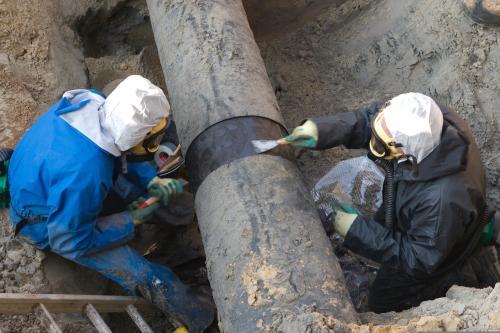By Jessica Parnham
Head of Marketing and Content Strategy
Asbestos is a well-recognised hazard in the UK, and for many dutyholders, estates teams and project managers, its risks are already understood. But recognition alone is not enough to prevent exposure, and recent statistics show that asbestos-related illness remains one of the country’s leading causes of work-related death.
This Global Asbestos Awareness Week, we are highlighting why asbestos continues to pose a threat in 2025, where it is still likely to be found, and how assumptions about safety can leave buildings, projects and people exposed. In doing so, we hope to support those responsible for managing asbestos in making informed, preventative decisions that protect both health and compliance.
Where is Asbestos Found?
The UK banned the use of all types of asbestos in 1999. However, because asbestos was widely used in construction materials throughout the twentieth century, it remains present in hundreds of thousands of buildings constructed or refurbished before the year 2000.
Asbestos-containing materials (ACMs) were commonly used in insulation boards, pipe lagging, textured coatings, ceiling panels, floor tiles and other structural elements. These materials may still be present in older commercial, residential and public buildings unless they have been professionally identified and removed.
Banning a material does not remove it from circulation. In the case of asbestos, that misunderstanding can lead to serious exposure risks for those who assume a building is safe without the evidence to confirm it.
The Hidden Dangers of Asbestos
One of the most significant challenges in managing asbestos risk is that much of the material is hidden and undocumented. Without formal asbestos surveys, it is not always clear whether a building contains asbestos or where it might be located.
Asbestos-containing materials may remain undisturbed for decades behind walls, above ceiling tiles or within service voids. These areas are often accessed during refurbishment, demolition or maintenance works, where asbestos can be disturbed without warning.
This uncertainty is further complicated by the long latency period of asbestos-related illnesses. Diseases such as mesothelioma or asbestos-induced lung cancer can take between 20 and 40 years to present symptoms. Once diagnosed, these conditions are irreversible and often fatal, which is why early detection and prevention are so critical.
The Continued Impact of Asbestos Exposure
Exposure to asbestos often occurs without immediate symptoms. When asbestos-containing materials are disturbed, microscopic fibres can become airborne and inhaled without anyone realising. These fibres are invisible to the naked eye and can settle deep into the lungs, where they can remain for years before any health effects are detected.
This delayed onset is one of the reasons asbestos-related illness continues to have such a significant impact. According to the Health and Safety Executive (HSE), asbestos remains the leading cause of occupational disease in the UK. Around 5,000 people still die each year as a result of asbestos-related illnesses, including lung cancer, mesothelioma and asbestosis.
In the construction industry, asbestos continues to pose a particularly serious risk, accounting for approximately 70% of occupational cancer cases in this sector. These statistics highlight not just the legacy of past exposure, but the need for ongoing vigilance in present-day worksites and buildings.
Who is Most at Risk from Asbestos?
Asbestos remains a widespread risk for those working in and around buildings constructed before 2000. This includes a wide range of industries and environments, particularly where refurbishment or maintenance is ongoing.
People most likely to be at risk include tradespeople, caretakers, contractors and maintenance staff, as well as those occupying or managing:
- Schools, universities and educational buildings
- Hospitals, GP surgeries and healthcare facilities
- Housing associations, council properties and care homes
- Offices, industrial units and older commercial sites
In many cases, asbestos exposure results from a lack of up-to-date information or the absence of a recent asbestos survey. Even a well-intentioned maintenance job or upgrade can become hazardous when the presence of asbestos is not properly accounted for in advance.
Awareness Paired with Action
Raising awareness of the risks associated with asbestos is essential. But as we noted in our previous article on Effective Asbestos Management, awareness must be paired with action.
At Envirochem, we support clients in recognising, understanding and responding to this risk. Our consultants provide independent asbestos surveys tailored to your site and scope of work, along with air monitoring, fibre identification and laboratory analysis. We also offer ongoing guidance to help dutyholders plan safe, compliant works that minimise disruption and protect both workers and building occupants.
If you are unsure where to start, or require professional support identifying and managing risk in your building or property portfolio, get in touch with one of our experts today.
Author
Related Content
How can we help?
Contact UsWebsite Privacy Policy - Privacy Notice - Terms & Conditions
© Envirochem Analytical Laboratories Ltd
Reg. No. 2378228 England



